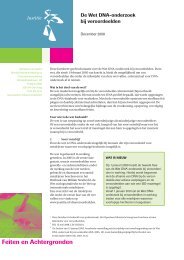INTERPOL HANDBOOK ON DNA DATA EXCHANGE AND PRACTICE
INTERPOL HANDBOOK ON DNA DATA EXCHANGE AND PRACTICE
INTERPOL HANDBOOK ON DNA DATA EXCHANGE AND PRACTICE
You also want an ePaper? Increase the reach of your titles
YUMPU automatically turns print PDFs into web optimized ePapers that Google loves.
•back to basics: the use of dna in criminalinvestigations<strong>DNA</strong>During the commission of a violent crime, it is reasonable to expect that body fluidssuch as blood or semen will be transferred between the victim, the suspect and thecrime scene. This concept of “Every contact leaves a trace”, the cross transfer of physicalevidence, was first stated by Dr Edmond Locard, who was Director of the first crimelaboratory in Lyon, France, in the early 20th century. This statement became knownas Locard’s Exchange Principle, and established the foundations of forensic science.Physical evidence recovered from the crime scene can be used to associate an individualwith the crime (for example through <strong>DNA</strong> profiling or fingerprints). It is also possible toreconstruct the events of the crime through techniques such as blood pattern analysisand other crime scene reconstruction techniques. It is the decision of the investigatingofficer to identify the need for forensic examination and the responsibility of trainedforensic personnel to successfully recover this physical evidence from the crime scene,undertake the subsequent scientific examination and report the results of the analysisas a statement of evidence or as court testimony.<strong>DNA</strong> can be used as evidence due to a few basic scientific facts.<strong>DNA</strong> is present in every cell (excluding red blood cells) and for the purposes of <strong>DNA</strong>profiling is unique to every individual (except identical twins). The analysis of cells leftat a scene allows for the <strong>DNA</strong> present to be profiled and a unique sequence for aparticular individual to be determined (see Appendix 3 for detail). Cells containing <strong>DNA</strong>can be found in many different sources of biological evidence (see <strong>DNA</strong> sampling andevidence collection).•why is forensic dna profiling important forlaw enforcement?<strong>DNA</strong> profiling first achieved public recognition in 1987 when it was used in a highprofilecase where <strong>DNA</strong> evidence led to the successful conviction of a dangerous sexoffender and the exclusion of an innocent suspect. The continual emerging strength of<strong>DNA</strong> profiling is its ability to allow a large number of samples to be compared witha high degree of reliability. The profiling techniques being developed fit more closelywith standard specifications and are more applicable to the routine analysis of crimescene samples, often obtained from high-volume crime. The increasing number of <strong>DNA</strong>profiles that are sent for comparison has required the development of <strong>DNA</strong> Databasesso that we are able to accurately and efficiently match and manage the data.<strong>DNA</strong> PAGE 7







